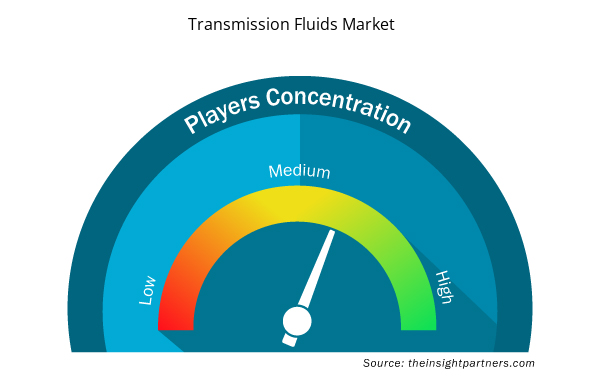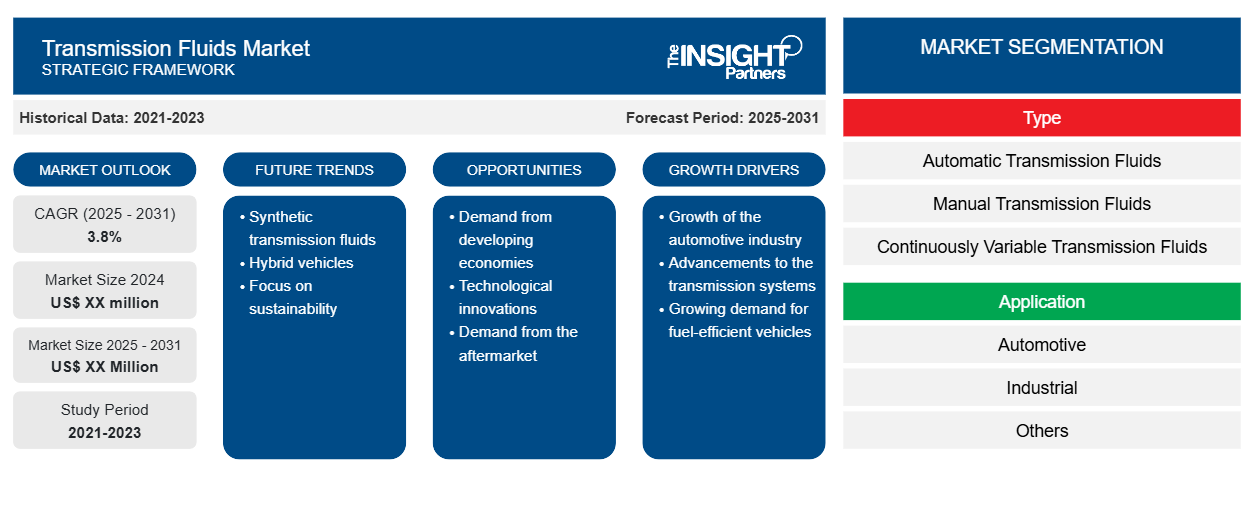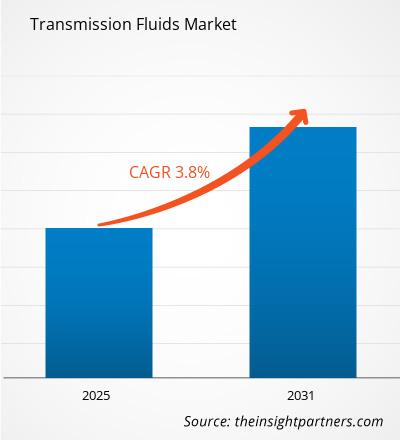Se espera que el mercado de fluidos de transmisión registre una CAGR del 3,8 % entre 2024 y 2031, con un tamaño de mercado que se expandirá de US$ XX millones en 2024 a US$ XX millones en 2031.
El informe está segmentado por tipo (fluidos de transmisión automática (ATF), fluidos de transmisión manual (MTF), fluidos de transmisión continuamente variable (CVT) y fluidos de transmisión de doble embrague (DCTF)). El informe está segmentado aún más por aplicación (automotriz, industrial y otros). El informe presenta además un análisis basado en la industria de uso final (vehículos de pasajeros, vehículos pesados, vehículos todoterreno y otros). El alcance del informe cubre cinco regiones: América del Norte, Europa, Asia Pacífico, Medio Oriente y África, y América del Sur y Central y países clave dentro de cada región. El análisis global se desglosa aún más a nivel regional y países principales. El informe ofrece el valor en USD para el análisis y los segmentos anteriores.
Propósito del Informe
El informe sobre el mercado de fluidos de transmisión de The Insight Partners tiene como objetivo describir el panorama actual y el crecimiento futuro, los principales factores impulsores, los desafíos y las oportunidades. Esto proporcionará información a diversas partes interesadas del negocio, como:
- Proveedores/fabricantes de tecnología: Para comprender la dinámica cambiante del mercado y conocer las oportunidades potenciales de crecimiento, lo que les permitirá tomar decisiones estratégicas informadas.
- Inversionistas: Realizar un análisis exhaustivo de tendencias sobre la tasa de crecimiento del mercado, las proyecciones financieras del mercado y las oportunidades que existen en toda la cadena de valor.
- Órganos reguladores: Regular las políticas y vigilar las actividades del mercado con el objetivo de minimizar los abusos, preservar la confianza de los inversores y defender la integridad y estabilidad del mercado.
Segmentación del mercado de fluidos de transmisión
Tipo
- Fluidos de transmisión automática
- Fluidos de transmisión manual
- Fluidos de transmisión continuamente variables
- Fluidos para transmisión de doble embrague
Solicitud
- Automotor
- Industrial
- Otros
Industria de uso final
- Vehículos de pasajeros
- Vehículos pesados
- Vehículos todoterreno
- Otros
Geografía
- América del norte
- Europa
- Asia-Pacífico
- América del Sur y Central
- Oriente Medio y África
Personalice este informe según sus necesidades
Obtendrá personalización en cualquier informe, sin cargo, incluidas partes de este informe o análisis a nivel de país, paquete de datos de Excel, así como también grandes ofertas y descuentos para empresas emergentes y universidades.
- Obtenga las principales tendencias clave del mercado de este informe.Esta muestra GRATUITA incluirá análisis de datos, desde tendencias del mercado hasta estimaciones y pronósticos.
Factores impulsores del crecimiento del mercado de fluidos de transmisión
- Growth of the automotive industry: The global automotive market is still growing, especially in emerging economies like China, India, and Brazil. There is an increasing number of cars on the roads, and the demand for transmission fluids also increases proportionally. Moreover, the continuing growth in the number of vehicles manufactured, especially passenger and commercial, goes hand in hand with advancements in automotive technologies (automatic, dual-clutch, and continuously variable transmissions) that demand specialized fluids. In addition, the increasing number of electric and hybrid automobiles, which require complex transmissions, is another factor behind the increasing market of transmission fluids.
- Advancements to the transmission systems: Continuous technological advancement relates to vehicle transmission systems, such as dual-clutch transmissions (DCT), continuously variable transmissions (CVT), and automated manual transmissions (AMT). Specialist transmission fluids are needed for these technologies. They demand better, higher-performance fluids for smoother gear shifting, less friction, and better fuel efficiency. Manufacturers have improved constantly the formulation of such transmission fluids--for example, by developing synthetic fluids that provide longer-lasting protection, higher-temperature resistance, and better performance under extreme conditions.
- Growing demand for fuel-efficient vehicles: Increasing demands for fuel efficiency and improved vehicle performance. Transmission fluids have an important role here as they minimize friction, contribute towards increasing the life of the overall transmission system, and ensure an optimum shift process. With growing concerns about the environment and stringent regulations for fuel efficiency, high-performance, fuel-efficient transmission fluids have become an important option. These fluids make the vehicle much more effective overall, decrease fuel consumption, and decrease CO2 emission, making them an important product in modern automotive manufacturing.
Transmission Fluids Market Future Trends
- Synthetic transmission fluids: Synthetic transmission fluids have become the most widely used at present since they provide superior performance at extremes, longer intervals, and better wear protection. The adoption of this fluid is significant since consumers and car manufacturers seek more from their vehicle in terms of performance and longevity.
- Hybrid vehicles: Electric vehicles in themselves do not really use classic transmission fluids. Hence, while hybrid vehicles which make use of both electric and internal combustion engines increase the requirement for specific fluids, upgrading of electric drivetrain and high performance hybrid systems requires advanced fluids so that the electric powertrains are going to be efficient and durable.
- Focus on sustainability: With environmental sustainability on the rise, consumers and manufacturers are required to develop alternatives in their automotive products that are sustainable. The manufacturers of transmission fluids have responded with environmentally friendly offerings, including biodegradable fluids and products with a lower environmental impact. Such fluids help reduce emissions by vehicles and promote overall sustainability within the industry, allowing companies to be environmentally sensitive. Packaging for transmission fluids also gains more focus on being recyclable.
Transmission Fluids Market Opportunities
- Demand from developing economies: Emerging markets, particularly in Asia-Pacific, Latin America, and Africa, are growing at a tremendous pace in the automotive sector. This is an attractive proposition for manufacturers in fluid transmission, as demand for automotive fluids will continue to grow in these markets with the increases in vehicle production and ownership. Consequently, demand for high-quality transmission fluids, particularly for passenger and commercial vehicles, will continue to grow.
- Technological innovations: The continuously and increasingly more sophisticated transmission systems, along with the newer dual-clutch transmissions (DCT), continuously variable transmissions (CVT), and hybrid vehicle transmissions, demand new fluids that are specialized for these advanced transmission systems. Companies can reap this benefit by developing fluids that are customized according to the needs of the new, more advanced systems. Increased complexity in automotive drivetrains, therefore creates a large growth opportunity for companies that can provide highly specialized transmission fluids with significant performance characteristics.
- Demand from the aftermarket: With the ever-increasing number of automobiles on the roads and the continued operation of older vehicles for extended periods, there is an increasing demand for aftermarket transmission fluids. Suppliers have a wide window of opportunity in the extensive network of the aftermarket, ranging from auto parts retailers to service centers and online platforms. It suggests a rising opportunity for manufacturers to meet the needs of quality aftermarkets for transmission fluids, particularly in a market where there exists a large quantity of vehicles.
Transmission Fluids Market Regional Insights
The regional trends and factors influencing the Transmission Fluids Market throughout the forecast period have been thoroughly explained by the analysts at Insight Partners. This section also discusses Transmission Fluids Market segments and geography across North America, Europe, Asia Pacific, Middle East and Africa, and South and Central America.

- Get the Regional Specific Data for Transmission Fluids Market
Transmission Fluids Market Report Scope
| Report Attribute | Details |
|---|---|
| Market size in 2024 | US$ XX million |
| Market Size by 2031 | US$ XX Million |
| Global CAGR (2025 - 2031) | 3.8% |
| Historical Data | 2021-2023 |
| Forecast period | 2025-2031 |
| Segments Covered | By Type
|
| Regions and Countries Covered | North America
|
| Market leaders and key company profiles |
|
Transmission Fluids Market Players Density: Understanding Its Impact on Business Dynamics
The Transmission Fluids Market market is growing rapidly, driven by increasing end-user demand due to factors such as evolving consumer preferences, technological advancements, and greater awareness of the product's benefits. As demand rises, businesses are expanding their offerings, innovating to meet consumer needs, and capitalizing on emerging trends, which further fuels market growth.
Market players density refers to the distribution of firms or companies operating within a particular market or industry. It indicates how many competitors (market players) are present in a given market space relative to its size or total market value.
Major Companies operating in the Transmission Fluids Market are:
- BASF SE
- BP plc
- Chevron Corporation
- Exxon Mobil Corporation
- FUCHS PETROLUB SE
Disclaimer: The companies listed above are not ranked in any particular order.

- Get the Transmission Fluids Market top key players overview
Key Selling Points
- Comprehensive Coverage: The report comprehensively covers the analysis of products, services, types, and end users of the Transmission Fluids Market, providing a holistic landscape.
- Expert Analysis: The report is compiled based on the in-depth understanding of industry experts and analysts.
- Up-to-date Information: The report assures business relevance due to its coverage of recent information and data trends.
- Customization Options: This report can be customized to cater to specific client requirements and suit the business strategies aptly.
The research report on the Transmission Fluids Market can, therefore, help spearhead the trail of decoding and understanding the industry scenario and growth prospects. Although there can be a few valid concerns, the overall benefits of this report tend to outweigh the disadvantages.
- Análisis histórico (2 años), año base, pronóstico (7 años) con CAGR
- Análisis PEST y FODA
- Tamaño del mercado Valor/volumen: global, regional, nacional
- Industria y panorama competitivo
- Conjunto de datos de Excel


- Emergency Department Information System (EDIS) Market
- Mail Order Pharmacy Market
- Cling Films Market
- Rugged Servers Market
- Quantitative Structure-Activity Relationship (QSAR) Market
- Artwork Management Software Market
- Passport Reader Market
- Medical Devices Market
- Batter and Breader Premixes Market
- Automotive Fabric Market

Report Coverage
Revenue forecast, Company Analysis, Industry landscape, Growth factors, and Trends

Segment Covered
This text is related
to segments covered.

Regional Scope
North America, Europe, Asia Pacific, Middle East & Africa, South & Central America

Country Scope
This text is related
to country scope.
Preguntas frecuentes
A shift toward synthetic and high-performance transmission fluids is expected to be the key market trend.
The report can be delivered in PDF/Word format, we can also share excel data sheet based on request.
On the basis of geography, the transmission fluids market is classified into North America, Europe, Asia Pacific, Middle East and Africa, and South and Central America
The major factors driving the transmission fluids market are:
1. Growth in Automotive Production and Sales.
2. Technological Advancements in Transmission Systems.
ExxonMobil Corp, Shell Plc, Chevron Corp, Castrol India Ltd, TotalEnergies SE, Valvoline Inc, Liqui Moly, Fuchs SE, and Amsoil Inc
The Transmission Fluids Market is estimated to witness a CAGR of 3.8% from 2023 to 2031
Trends and growth analysis reports related to Chemicals and Materials : READ MORE..
1. BASF SE
2. BP plc
3. Chevron Corporation
4. Exxon Mobil Corporation
5. FUCHS PETROLUB SE
6. Petroliam Nasional Berhad (PETRONAS)
7. PJSC LUKOIL
8. Royal Dutch Shell plc
9. The Lubrizol Corporation
10. TOTAL S. A.
The Insight Partners performs research in 4 major stages: Data Collection & Secondary Research, Primary Research, Data Analysis and Data Triangulation & Final Review.
- Data Collection and Secondary Research:
As a market research and consulting firm operating from a decade, we have published and advised several client across the globe. First step for any study will start with an assessment of currently available data and insights from existing reports. Further, historical and current market information is collected from Investor Presentations, Annual Reports, SEC Filings, etc., and other information related to company’s performance and market positioning are gathered from Paid Databases (Factiva, Hoovers, and Reuters) and various other publications available in public domain.
Several associations trade associates, technical forums, institutes, societies and organization are accessed to gain technical as well as market related insights through their publications such as research papers, blogs and press releases related to the studies are referred to get cues about the market. Further, white papers, journals, magazines, and other news articles published in last 3 years are scrutinized and analyzed to understand the current market trends.
- Primary Research:
The primarily interview analysis comprise of data obtained from industry participants interview and answers to survey questions gathered by in-house primary team.
For primary research, interviews are conducted with industry experts/CEOs/Marketing Managers/VPs/Subject Matter Experts from both demand and supply side to get a 360-degree view of the market. The primary team conducts several interviews based on the complexity of the markets to understand the various market trends and dynamics which makes research more credible and precise.
A typical research interview fulfils the following functions:
- Provides first-hand information on the market size, market trends, growth trends, competitive landscape, and outlook
- Validates and strengthens in-house secondary research findings
- Develops the analysis team’s expertise and market understanding
Primary research involves email interactions and telephone interviews for each market, category, segment, and sub-segment across geographies. The participants who typically take part in such a process include, but are not limited to:
- Industry participants: VPs, business development managers, market intelligence managers and national sales managers
- Outside experts: Valuation experts, research analysts and key opinion leaders specializing in the electronics and semiconductor industry.
Below is the breakup of our primary respondents by company, designation, and region:

Once we receive the confirmation from primary research sources or primary respondents, we finalize the base year market estimation and forecast the data as per the macroeconomic and microeconomic factors assessed during data collection.
- Data Analysis:
Once data is validated through both secondary as well as primary respondents, we finalize the market estimations by hypothesis formulation and factor analysis at regional and country level.
- Macro-Economic Factor Analysis:
We analyse macroeconomic indicators such the gross domestic product (GDP), increase in the demand for goods and services across industries, technological advancement, regional economic growth, governmental policies, the influence of COVID-19, PEST analysis, and other aspects. This analysis aids in setting benchmarks for various nations/regions and approximating market splits. Additionally, the general trend of the aforementioned components aid in determining the market's development possibilities.
- Country Level Data:
Various factors that are especially aligned to the country are taken into account to determine the market size for a certain area and country, including the presence of vendors, such as headquarters and offices, the country's GDP, demand patterns, and industry growth. To comprehend the market dynamics for the nation, a number of growth variables, inhibitors, application areas, and current market trends are researched. The aforementioned elements aid in determining the country's overall market's growth potential.
- Company Profile:
The “Table of Contents” is formulated by listing and analyzing more than 25 - 30 companies operating in the market ecosystem across geographies. However, we profile only 10 companies as a standard practice in our syndicate reports. These 10 companies comprise leading, emerging, and regional players. Nonetheless, our analysis is not restricted to the 10 listed companies, we also analyze other companies present in the market to develop a holistic view and understand the prevailing trends. The “Company Profiles” section in the report covers key facts, business description, products & services, financial information, SWOT analysis, and key developments. The financial information presented is extracted from the annual reports and official documents of the publicly listed companies. Upon collecting the information for the sections of respective companies, we verify them via various primary sources and then compile the data in respective company profiles. The company level information helps us in deriving the base number as well as in forecasting the market size.
- Developing Base Number:
Aggregation of sales statistics (2020-2022) and macro-economic factor, and other secondary and primary research insights are utilized to arrive at base number and related market shares for 2022. The data gaps are identified in this step and relevant market data is analyzed, collected from paid primary interviews or databases. On finalizing the base year market size, forecasts are developed on the basis of macro-economic, industry and market growth factors and company level analysis.
- Data Triangulation and Final Review:
The market findings and base year market size calculations are validated from supply as well as demand side. Demand side validations are based on macro-economic factor analysis and benchmarks for respective regions and countries. In case of supply side validations, revenues of major companies are estimated (in case not available) based on industry benchmark, approximate number of employees, product portfolio, and primary interviews revenues are gathered. Further revenue from target product/service segment is assessed to avoid overshooting of market statistics. In case of heavy deviations between supply and demand side values, all thes steps are repeated to achieve synchronization.
We follow an iterative model, wherein we share our research findings with Subject Matter Experts (SME’s) and Key Opinion Leaders (KOLs) until consensus view of the market is not formulated – this model negates any drastic deviation in the opinions of experts. Only validated and universally acceptable research findings are quoted in our reports.
We have important check points that we use to validate our research findings – which we call – data triangulation, where we validate the information, we generate from secondary sources with primary interviews and then we re-validate with our internal data bases and Subject matter experts. This comprehensive model enables us to deliver high quality, reliable data in shortest possible time.


 Obtenga una muestra gratuita de este informe
Obtenga una muestra gratuita de este informe